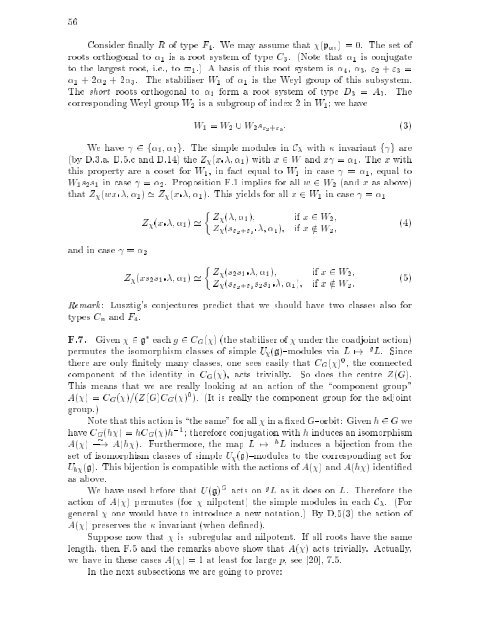subregular nilpotent representations of lie algebras in prime ...
subregular nilpotent representations of lie algebras in prime ...
subregular nilpotent representations of lie algebras in prime ...
Create successful ePaper yourself
Turn your PDF publications into a flip-book with our unique Google optimized e-Paper software.
56<br />
Consider nally R <strong>of</strong> type F4. Wemay assume that (p 1) = 0. The set <strong>of</strong><br />
roots orthogonal to 1 is a root system <strong>of</strong> type C3. (Note that 1 is conjugate<br />
to the largest root, i.e., to $1.) A basis <strong>of</strong> this root system is 4, 3, "2 + "3 =<br />
1 +2 2 +2 3. The stabiliser W1 <strong>of</strong> 1 is the Weyl group <strong>of</strong> this subsystem.<br />
The short roots orthogonal to 1 formarootsystem<strong>of</strong>type D3 = A3. The<br />
correspond<strong>in</strong>g Weyl group W2 is a subgroup <strong>of</strong> <strong>in</strong>dex 2 <strong>in</strong> W1; wehave<br />
W1 = W2 [ W2s"2+"3: (3)<br />
We have 2f 1; 2g. The simple modules <strong>in</strong> C with <strong>in</strong>variant f g are<br />
(by D.3.a, D.5.c and D.14) the Z (x ; 1) withx 2 W and x = 1. The x with<br />
this property are a coset for W1, <strong>in</strong> fact equal to W1 <strong>in</strong> case = 1, equal to<br />
W1s2s1 <strong>in</strong> case = 2. Proposition F.1 imp<strong>lie</strong>s for all w 2 W2 (and x as above)<br />
that Z (wx ; 1) ' Z (x ; 1). This yields for all x 2 W1 <strong>in</strong> case = 1<br />
and <strong>in</strong> case = 2<br />
Z (x ; 1) ' Z ( ; 1); if x 2 W2,<br />
Z (s"2+"3 ; 1); if x=2 W2,<br />
Z (xs2s1 ; 1) ' Z (s2s1 ; 1); if x 2 W2,<br />
Z (s"2+"3s2s1 ; 1); if x=2 W2.<br />
Remark: Lusztig's conjectures predict that we should have two classes also for<br />
types Cn and F4.<br />
F.7. Given 2 g each g 2 CG( ) (the stabiliser <strong>of</strong> under the coadjo<strong>in</strong>t action)<br />
permutes the isomorphism classes <strong>of</strong> simple U (g){modules via L 7! g L. S<strong>in</strong>ce<br />
there are only nitely many classes, one sees easily that CG( ) 0 , the connected<br />
component <strong>of</strong> the identity <strong>in</strong>CG( ), acts trivially. So does the centre Z(G).<br />
This means that we are really look<strong>in</strong>g at an action <strong>of</strong> the \component group"<br />
A( )=CG( )=(Z(G)CG( ) 0 ). (It is really the component group for the adjo<strong>in</strong>t<br />
group.)<br />
Note that this action is \the same" for all <strong>in</strong>a xedG{orbit: Given h 2 G we<br />
have CG(h )=hCG( )h ,1 ; therefore conjugation with h <strong>in</strong>duces an isomorphism<br />
A( ) ,! A(h ). Furthermore, the map L 7! h L <strong>in</strong>duces a bijection from the<br />
set <strong>of</strong> isomorphism classes <strong>of</strong> simple U (g){modules to the correspond<strong>in</strong>g set for<br />
Uh (g). This bijection is compatible with the actions <strong>of</strong> A( ) and A(h )identi ed<br />
as above.<br />
We have used before that U(g) G acts on g L as it does on L. Therefore the<br />
action <strong>of</strong> A( ) permutes (for <strong>nilpotent</strong>) the simple modules <strong>in</strong> each C . (For<br />
general one would have to<strong>in</strong>troduce a new notation.) By D.5(3) the action <strong>of</strong><br />
A( ) preserves the <strong>in</strong>variant (when de ned).<br />
Suppose now that is <strong>subregular</strong> and <strong>nilpotent</strong>. If all roots have the same<br />
length, then F.5 and the remarks above show that A( ) acts trivially. Actually,<br />
we have <strong>in</strong> these cases A( ) = 1 at least for large p, see [20], 7.5.<br />
In the next subsections we are go<strong>in</strong>g to prove:<br />
(4)<br />
(5)

















